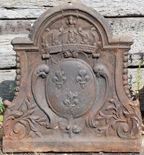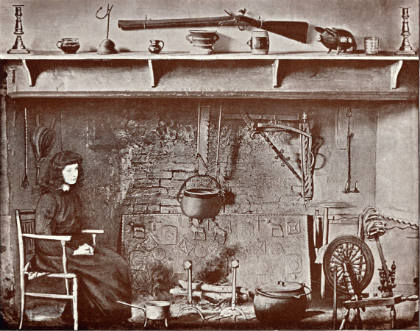Firebacks began to be made in Germany at the end of the fifteenth century. From their beginning the opportunity was taken to embellish their plain surfaces, firstly using simple objects, then with carved motifs and later with entire designs moulded from carved patterns or models. Firebacks probably began to be made in England in the first quarter of the sixteenth century, in the decades following the introduction of cast iron to these islands. Their heyday was the seventeenth century, but they continue to be made as special commissions to this day. There is also a market in second-hand firebacks, in copies cast from originals and in pastiches of earlier designs.
This database began to be assembled during research for the book, British Cast-Iron Firebacks of the 16th to Mid-18th Centuries by Jeremy Hodgkinson (Hodgers Books, Crawley, 2010), which is now out of print. That research has been refocused into the British Fireback Survey, the compilation of a catalogue of the types and designs of firebacks made in Britain, which is destined for deposit in a national library. Using the Database Search link at the top of this page you can look for details and pictures of cast-iron firebacks not only from Britain but also some from continental Europe, many examples of which have found their way into Britain, particularly since the second half of the seventeenth century. If you already know the identification number of a fireback in the database just enter the number in the box at the top of the Search page and press Go.
Where a number of firebacks have been identified as having characteristics suggesting a common source or pattern maker, they have been allocated a series. Firebacks with similar decorative elements, such as armorials of a particular reign or the same allegorical subject, are also grouped. Clicking on a series or other grouping in the description of a fireback will reveal others in the series or group.
This database will be added to as new examples are recorded, and the Editor will be delighted to receive details (including a photograph and dimensions) of examples visitors to the site think could be added. He will also be happy to assist in the identification of firebacks readers encounter or have in their possession.
Many firebacks are copies but these are not replicas for they have been made using an earlier casting as the pattern, a practice almost as old as firebacks themselves. Copies will retain all the imperfections and wear of the casting used to make them. In some cases the only example of a fireback to have survived is a copy of a lost original. Commercially-produced copies were widely available in the late-19th and early-20th centuries. Replicas, however, are re-creations intended to look exactly the same as an original and using the same materials but not necessarily made by the same method.
The photographs of the firebacks are protected by the copyright of the owners of the places where they have been recorded and/or the photographers, and permission to use images for publication must be sought from the copyright holder, details of whom can be had from the Editor.
British firebacks can be grouped according to several criteria, the simplest being the source of the decoration from which the design was formed:



Many continental firebacks were imported into Britain:



- Follow me on Academia.edu where you can read more articles I have written about firebacks

